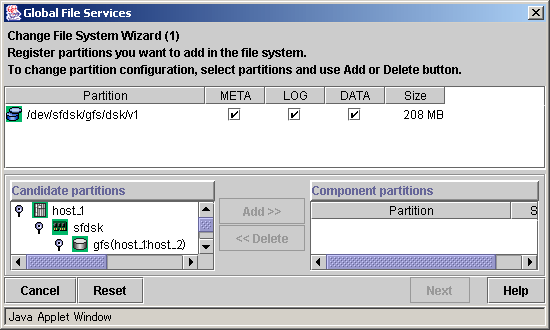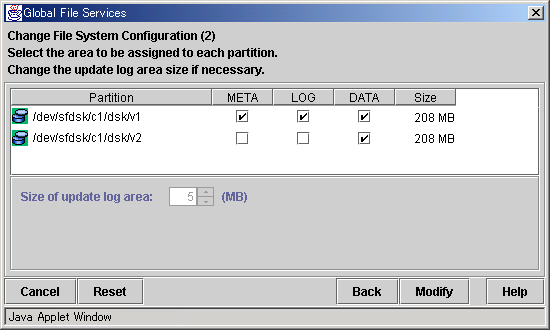

| PRIMECLUSTER Global File Services Configuration and Administration Guide 4.2 (Solaris(TM) Operating Environment) |
Contents
Index
 
|
| Part 3 Global File Services Shared File System | > Chapter 21 File System Operations (GUI) | > 21.3 Change |
This section explains the procedure for adding file data partition s.
s.
It is easy to change a file system's configuration because the file system configuration change operation uses a wizard.
To start the Change File System Configuration Wizard, click [Change Configuration] on the [Operation] drop-down menu.

Note of Operation
If the assigned values are invalid, the <Back> button may be clicked to display the previous screen.
(1) Unmount of a file system
Before the update log area is separated, the file system must be unmounted on all nodes.
File data and meta-data partitions can be added to a mounted file system.
(2) Setting shared disk device
The disk containing the partition s to be added to a GFS Shared File System must already be set a shared GDS
s to be added to a GFS Shared File System must already be set a shared GDS disk.
disk.
To specify a GDS logical volume as the target device, it must be active.

When registering a GDS logical volume with a class, set the disk type as shared and the scope to include all the nodes that share the GFS Shared File System.

For GDS disk class operations, see the applicable items under "Operation using Global Disk Services Management View" in the "PRIMECLUSTER Global Disk Services Configuration and Administration Guide."
For GDS logical volume operations, see the applicable items under "Operation using Global Disk Services Management View" in the "PRIMECLUSTER Global Disk Services Configuration and Administration Guide."
(3) Selecting a file system
From the [Mount tree] or [FileSystem Information] field in the main screen, select the file system to be changed. Only file systems of the sfcfs type can be selected.
Click [Change Configuration] on the [Operation] menu, the Change File System Configuration Wizard (1) screen appears.
(4) Selecting a partition
From the [Candidate partitions] field, select the partition  to be added and click the <Add> button. More than one partition can be selected at a time. Note that those partitions that are already in use for file systems cannot be selected.
to be added and click the <Add> button. More than one partition can be selected at a time. Note that those partitions that are already in use for file systems cannot be selected.

After selecting the partitions, click the <Next> button to continue. The next screen is shown in the following Figure Change File System Configuration Wizard (2).
To cancel the file system configuration change operation, click the <Cancel> button.
(5) Setting partition information
In the Change File System Configuration Wizard (2) screen, select the area to be assigned to each partition added with the Change File System Configuration Wizard (1) screen. By default, DATA is set for the area assigned to an added partition.

For an explanation of the combinations of areas (META/DATA) assigned to partitions, see Section 13.1.6, "Partition configuration."

Areas assigned to partitions
The following rules apply to the areas assigned to partitions:
- A DATA area is assigned to an added partition.
- The META area cannot be changed.


For an explanation of each parameter, see the explanation of sfcadd(1M) in Appendix F.2.1, "sfcadd(1M)."
After setting the information items, click the <Modify> to execute the file system configuration change operation.
To restore the settings to their previous values, click the <Reset> button.
To return to the Change File System Configuration Wizard (1), click the <Back> button.
To cancel the file system configuration change operation, click the <Cancel> button.
(6) Mount of a file system
After completion of the file system attribute change operation, mount the file system if the file system is unmounted.
Contents
Index
 
|